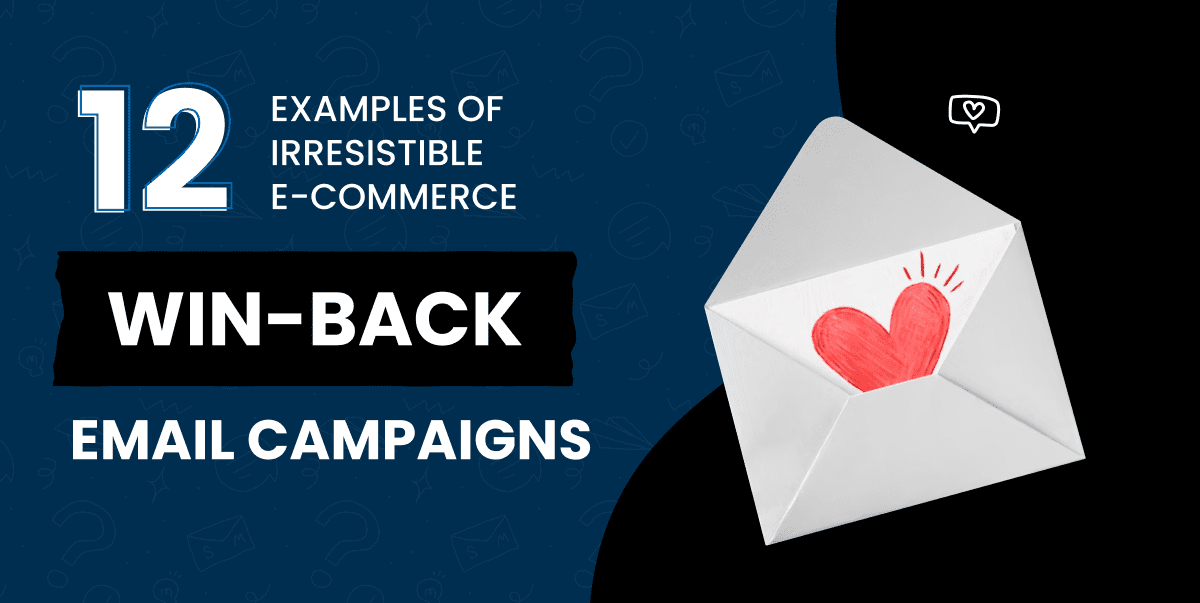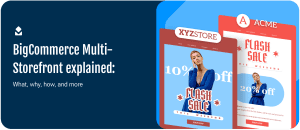When a new subscriber signs up to your store’s email list, this is the moment where they are the most engaged with your brand. After this, customers will eventually stop coming back to your e-commerce store and subscribers will stop engaging with your emails, no matter how good of an online shopping experience you may provide. Crafting an amazing win back email is key to re-engaging your customers.
You might think that winning back your inactive email list subscribers and customers is like trying to squeeze water out of a stone – that no matter what you do, they’ll never come back. But given that it’s at least 5 times more expensive to acquire a new customer than to retain an existing one, win-back email campaigns are a must-have in your email marketing arsenal.
If you haven’t already, I would highly recommend reading a previous post on our blog – How to Re-Engage and Win Back Your Store’s Customers with Email Marketing. This post provides a lot of information and best practice tips on how you can use email marketing to win back your customers.
As a follow up to this, here is a list of brilliant win-back email campaigns from other companies, to give you some inspiration for creating your own. So if you’re looking for sample emails to win back old customers, you’ve come to the right place.
Win Back Email Offer
The first email you send in your win-back campaign should include some sort of offer to recapture the attention of your subscribers. After all, 80% of people sign up to email lists to receive discounts.
1. American Apparel
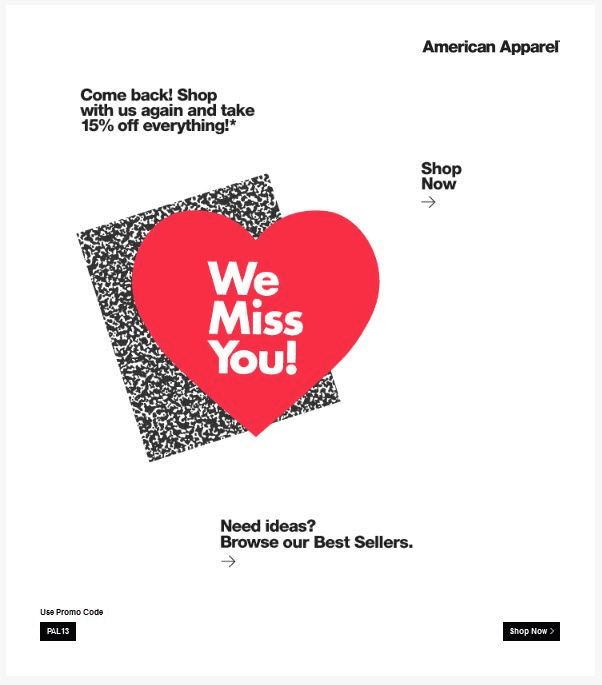
Inactive subscribers may not be particularly interesting in reading through dense and wordy copy in the body of a win-back email. The minimal copy in this email from American Apparel is concise, which helps to retain the attention of their subscribers, by keeping the message of the email short and sharp.
The email places heavy emphasis on the ‘We Miss You!’ graphic. However, I think the email should instead emphasize the 15% off discount code. This would boost the likelihood of customers following through with the call to action of the email to shop on their website.
2. Buca di Beppo

This win-back email from Italian-American restaurant chain Buca di Beppo has a lot of good things going for it.
Firstly, the image and caption in the top half of the email is engaging. This is combined with a red, white and green colour scheme, which helps to establish the restaurant’s brand.
The offer provided in this email gives the customer a number of options – they can spend it online, in one of their restaurants, and to dine in or to go. This makes the $20 gift certificate much more appealing to customers, who are more likely to make use of it.
However, this makes the email a little bit wordy overall and could have been more concise; a disengaged subscriber might not spend the time to read through and comprehend the email.
3. Sephora

The offer is really clear in this Sephora email. Like Buca di Beppo, they also provide an online and offline option for their $15 gift card, making the offer more enticing for customers.
By using separate buttons for the different calls to action, the layout of the email makes it neater and easier to read when compared to the email from Buca di Beppo. The buttons at the top of the email help readers to easily navigate to different sections of the Sephora website.
While I like the colourful visual design of the email, I think the inclusion of some images of their products would give subscribers some ideas of what they could be spend their gift card on.
Automate your Win Back series with SmartrMail today
? Install SmartrMail and check out our premade automations ?
4. Missguided

Rather than offering a discount, Missguided instead offer free next day delivery in this win-back email. This is something that small e-commerce stores can do, if a % off or x dollars off offer isn’t possible.
Similar to Sephora, the buttons at the top of the email provide a quick way for readers to click through to the section of the Missguided website that they’re interested in.
The fun but concise copy works well with the simple layout of the email, engaging readers while also allowing them to read through it easily and quickly. However, disengaged subscribers might not want to take the time and effort to scroll through the pretty long email.
5. The Bakerista
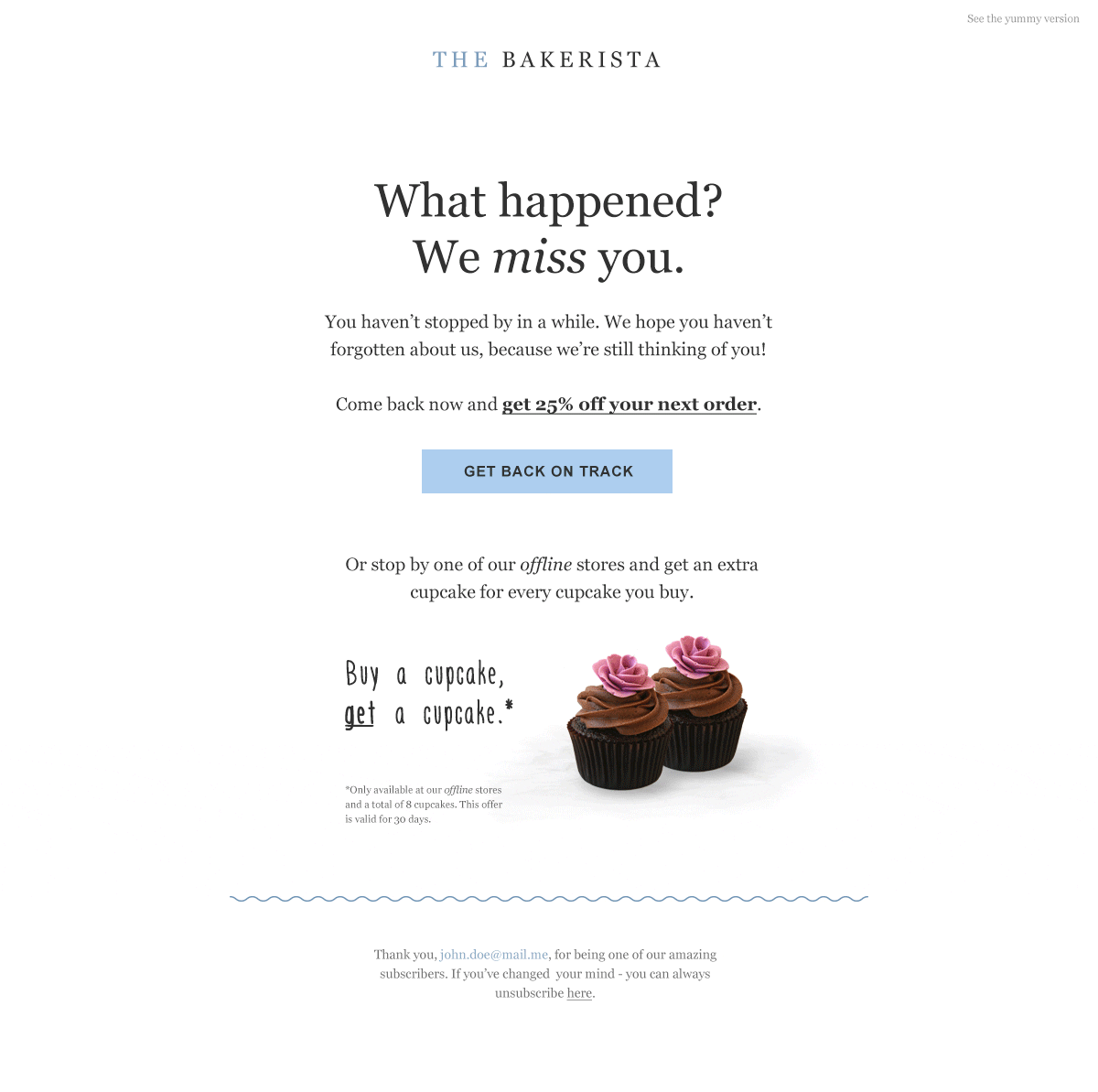
This email from The Bakerista is my favourite of the win-back emails targeting disengaged customers with offers. The design of the email is clean, and draws attention to the buttons and images. Again, their offer is able to be used in store or online, giving the customer more options to make use of the discount.
I also like their message at the very bottom of the email, which thanks the subscriber for being a part of their email list, and also giving them the option to unsubscribe if they wish.
However, my one small suggestion would be to have a stronger call to action. Something like ‘Order Now’ or ‘Get 25% Off’ would be better as call to actions than ‘Get Back On Track’.
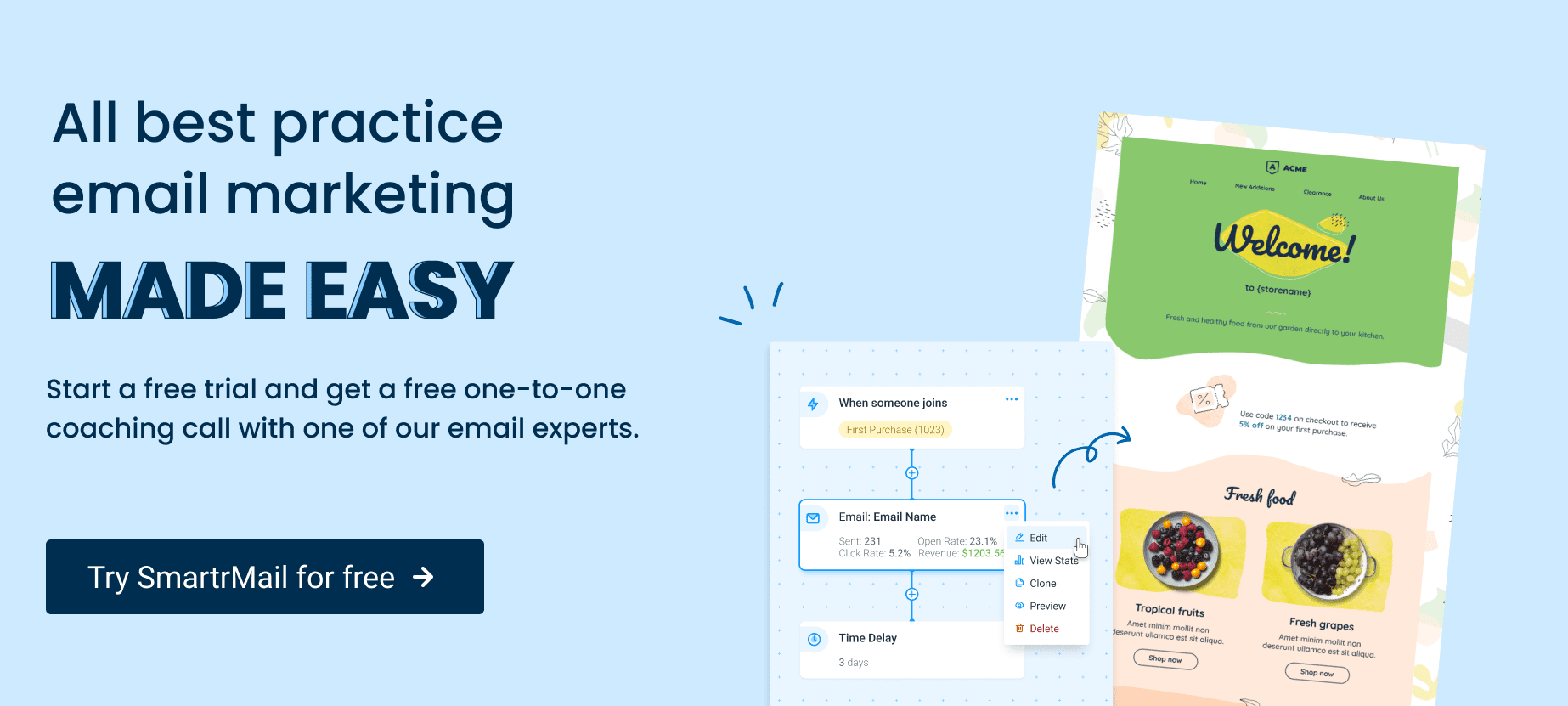
Win Back Email Benefits
The second email you should send in your win-back campaign is ‘the pivot’. This is your opportunity to let these inactive subscribers and customers know why they should be shopping at your e-commerce store. Basically, the aim of this email is to convince them to come back to you.
6. Polyvore
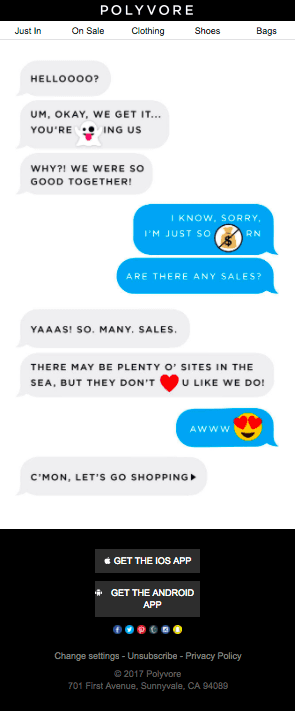
Opting for a Messenger format, Polyvore’s win-back email is visually appealing, and helps to position their brand as up to date and current. The copy is also easy for the reader to follow and subscribers are encouraged to read through the email by following the conversation. The call to action is also cleverly weaved into the design of the email.
While they mention that there are “So. Many. Sales.”, this is a little vague. Had Polyvore listed some specific sales at their store, this email might have been more convincing for customers to return to shop with them, by giving them a better idea of how they can benefit from these sales.
7. Astley Clarke

Although the design of this Astley Clarke email isn’t as eye catching as Polyvore, they do a much better job at convincing their inactive customers to return to shop at their store.
Despite being a bit lengthy for a win-back email, they make use of some funny copy in listing 17 benefits for coming back to Astley Clarke. This is effectively combined with an offer code, which generates urgency by mentioning that the offer ends in two days. As a result, customers are more likely to be won over.
The only thing I would improve with this email is to cut down the text. 17 seems like a strange number for the email to focus on. Instead, listing out 10 or even 15 reasons to shop at Astley Clarke would reduce the word count and make the email easier for readers to digest.
8. Spy

Spy’s email has all the elements you need to win back inactive subscribers on your email list.
They list a number of benefits for staying subscribed to receive their newsletter.
Listing fewer reasons than Astley Clarke did in their email, this email is cleaner and easier for subscribers to read. Each reason has different calls to action, allowing readers to click through to the content they’re interested in.
Spy even manages to include some social proof, with some positive reviews from other customers. This makes this win-back email all the more convincing for disengaged subscribers.
With a 20% off discount as the cherry on top, this makes Spy’s win-back email impossible to ignore.
Sign-up to our newsletter and receive a free eBook with hidden Email Marketing Tips
Remove inactive customers
Keeping your email list clean is important. First of all, constantly cleaning out your list helps you to keep a good deliverability rate. It also means that you won’t be wasting money sending newsletters to subscribers who won’t open them.
So as a last resort, you should do one of two things. The first option is asking your inactive subscriber if they wish to stay on your email list, manage their preferences or unsubscribe. This allows subscribers to actively choose whether they want to keep receiving your emails, receive fewer emails, or none at all.
Alternately, you could just let them know you have removed them from your email list, and then give them the option to resubscribe. I would recommend this second option – inactive subscribers are probably not going to read this email after ignoring the all the other ones you’ve sent them.
9. Nordstrom

Nordstrom get right to the point with this email. Without any distracting images or copy, this places the focus on the calls to action. By including an option to receive fewer emails, subscribers can manage their preferences to only receive relevant content.
As I previously stated, this allows subscribers to make a choice about their subscription to your newsletters. While some inactive subscribers may engage with this email, if they haven’t opened any of your previous newsletters or win-back emails, chances are that they won’t be inclined to open this one.
10. Urban Outfitters
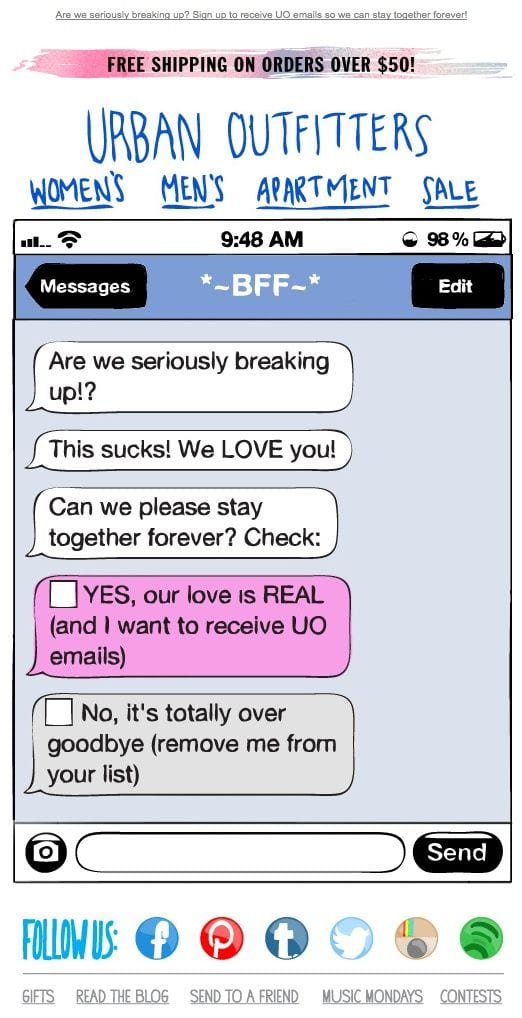
Like a similar email from Polyvore, Urban Outfitters’ email design has a Messenger format, which helps the brand feel current. Subscribers might feel more inclined to interact with this email, compared to one from Nordstrom, because of the engaging design and copy.
However, I would recommend allowing subscribers to manage their preferences. If they haven’t been opening your newsletters, you might be either sending them too many emails or irrelevant content. Allowing them to choose what they receive could keep them interested in your emails.

11. JetBlue
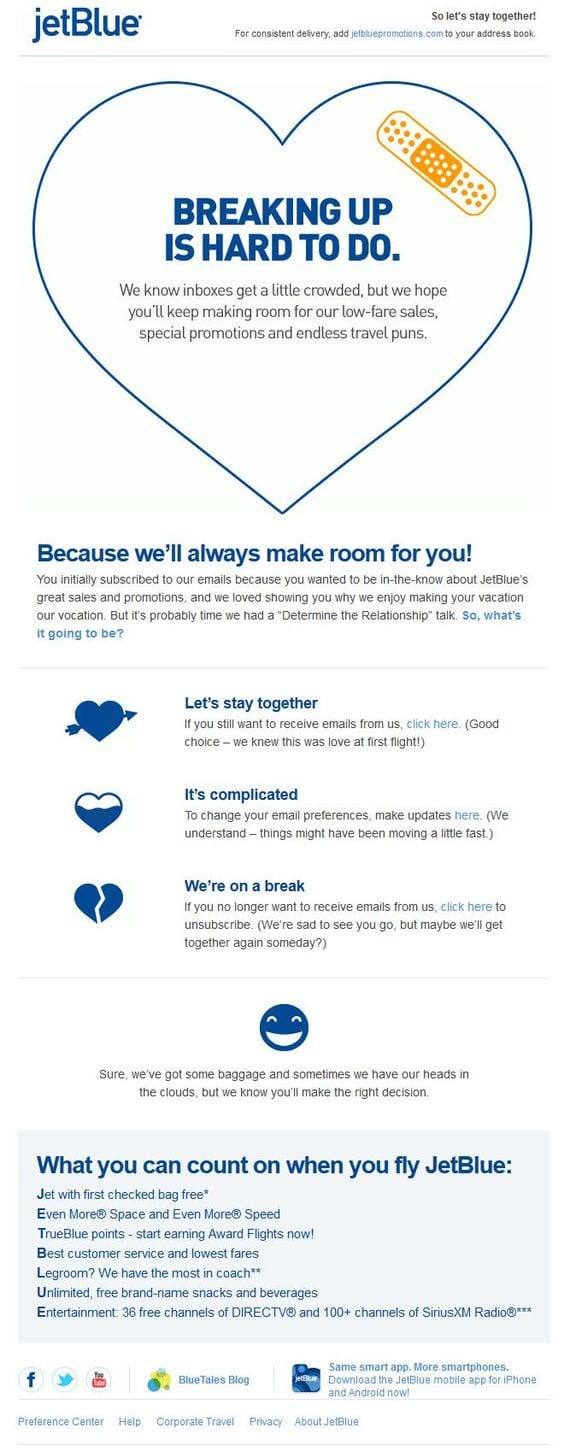
The main issue with this email from JetBlue is that it’s too wordy. To make this email more concise, I would cut down most of the copy, and probably remove the bottom third of the email. I do love an acrostic poem, but this might work better for JetBlue if they include it in an earlier win-back email.
I would also place more emphasis on the calls to action. By replacing the links with buttons, this would draw more attention to the calls to action and increase the likelihood that subscribers will click through.
12. DSW

DSW do their final win-back email well. The concise copy is able to be read quickly and easily, and works well with the image in the email. The call to action is clear, and invites the subscriber to actively engage with the email if they want to remain on the DSW email list.
If an inactive subscriber has reached this point in your win-back campaign, this means they haven’t opened your previous win-back emails or a number of your newsletters before this. Unfortunately, this means they probably won’t open your final win-back email either. Using a method similar to DSW basically means that you don’t have to send a fourth follow up if they remain inactive.
Conclusion
No matter how hard you try, sometimes you can’t just win back a lost customer or inactive subscriber. But that doesn’t mean you shouldn’t at least try. Armed with some inspiration and tips on creating your own win-back campaign, you should now start using email marketing to get subscribers to keep opening your emails and customers to keep returning to your e-commerce store.
You can also check out these customer reactivation strategies to increase you chances even further.
To give your winback emails the best chance of being opened, also be sure to check out our collection of winback subject lines.

